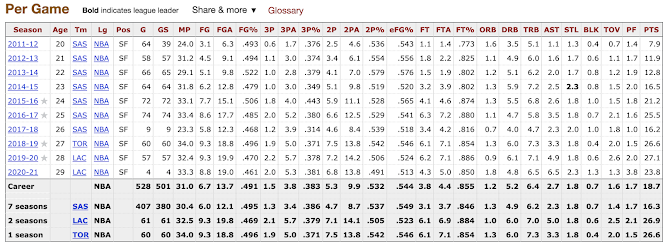"She's a great coach." What does that mean?
In Saban, the unauthorized bio of Alabama coach Nick Saban, his wife says (paraphrasing), "he isn't the greatest coach, but he is the greatest recruiter." As winning is the standard for big-time college sports, Saban gets the check mark.
Effective coaches:
- Get the most improvement and highest standard of performance from players.
- Get players to play harder and longer than opponents.
- Have teams that do not beat themselves.
- Take advantage of opponent mistakes.
- Achieve the above consistently.
Coach Dave Smart reminds us that another value of player development is not just skill, but competition that pushes top players and allows interchange in the event of injury or performance decline.
Kawhi Leonard shot 25 percent from three at San Diego State.
It can't be all shot selection as all shots are not equal.
He's not unique. Jaylen Brown shot 29 percent in one season at Cal and has averaged over 37 percent during four plus NBA campaigns.
Kawhi attributes it to shooting coach Chip Engelland. Engelland's reputation grew after a Grantland profile. Engelland shot over 55 percent from beyond the arc during his senior year at Duke.
During struggles for Steve Kerr, Engelland changed his routine, "Kerr and Engelland would sit alone on the bench in the Portland practice facility after everybody else had left. Engelland would ask Kerr to tell him what was going on with his kids or even leave him to read a newspaper. After a few minutes, Engelland would shout at Kerr to go, and the two would sprint off the bench and set Kerr up for a single 3-point attempt from the wing before returning to the bench. Repeat six more times and you’ve got the league’s most unlikely — and simultaneously most logical — shooting workout."
Aside from winning percentage, how would we measure coaching excellence? We rely on the eyeball test - organization, structure, teamwork, mistakes (e.g. turnovers), and effort. What is their intent? How does the game flow? Does the team adjust? What is the quality of the opposition? But it distills to execution...
"They have a winning culture." Bill Walsh defined winning culture with his "Standard of Performance" earning four Super Bowl titles. And he assumed a failing team and rebuilt it. A "positive culture" will not win without talent. In a youth sports setting, that may be acceptable.
We know of dysfunctional cultures like the 1970s Bronx Zoo, where the Yankees won despite their disagreements.
Walsh's culture focused on excellence at every level. He wanted peak performance from the person answering the phone, the guys striping the field, coaches, and players. The 49ers broke tasks into component parts and exacted execution excellence.
Considering the above, it's easy to know why winning is the gold standard. We rarely get "Hard Knocks" looks under the hood at team practices or culture. If not winning percentage, how else do you measure coaching?
Lagniappe. Nik knack. Stunning Jokic assists.
Lagniappe 2. You just had a career game in an OT win (28 points, 24 rebounds, 6 blocks, 16 for 21 free throws, an assist on your team's last hoop in regulation) after being named a top performer of the week. Ask the four questions:
1. What went well? Winning. Production. Crunch time performance, "rising."
2. What went less well? Work on conditioning and finishing through contact.
3. What could I improve? Grow the perimeter game.
4. What are the enduring lessons? Self-assessment drives the quest for excellence.

